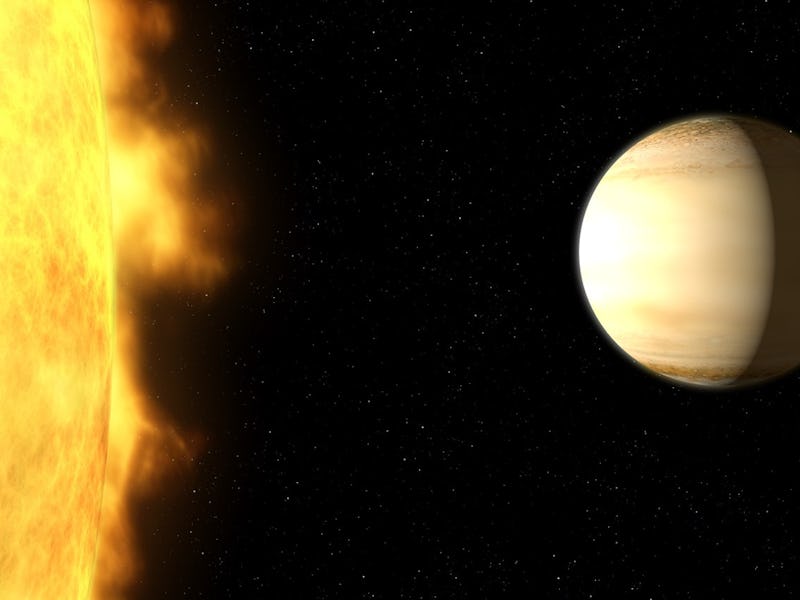Ultraviolet Light Produces A Toxic Gas in This Planet's Hellish Atmosphere
The gas giant's atmosphere is laced with sulfur dioxide.

Ultraviolet light blasting the atmosphere of giant exoplanet WASP-39b is producing a toxic gas called sulfur dioxide.
WASP-39b, an exoplanet about 700 light years away, is about as massive as Saturn, but it orbits its Sun-like star on a scorchingly close four-day orbit. Its hellishly hot 1600°F atmosphere contains carbon dioxide, water, and a noxious chemical called sulfur dioxide. According to a recent study, that sulfur dioxide is the product of a process called photochemistry, where ultraviolet radiation from the star triggers chemical reactions in the planet’s atmosphere.
Photochemistry is a key process in Earth’s atmosphere too, and on most of the planets in our Solar System. If University of California, Riverside astronomer Shang-Min Tsai and his colleagues are correct, it’s the first time astronomers have seen photochemistry in action on an exoplanet. And it could eventually help astronomers understand how different types of material in the disk around a newborn star clump together and form huge planets like WASP-39b.
This artist’s conception shows what WASP-39b might look like.
What’s New on WASP-39b
Using the James Webb Space Telescope’s Near InfraRed Spectrometer (NIRSpec), a team of astronomers discovered a surprising amount of sulfur dioxide in WASP-39b’s atmosphere. Sulfur dioxide, a sulfur atom bound to two oxygen atoms, wouldn’t be a weird thing to find in trace amounts in a gas giant’s atmosphere, but astronomers didn’t expect to find enough of it to detect with JWST’s instruments. Tsai and his colleagues tried a series of computer simulations to see what kinds of physical or chemical processes in the planet’s atmosphere could have created so much of the noxious chemical.
Here on Earth, sulfur dioxide is a pollutant created by burning certain fossil fuels; mixed with water in the atmosphere, it forms the acid in acid rain. We also use it to preserve dried fruit. Sulfur dioxide also gets belched out of volcanoes; Jupiter’s volcanically hyperactive hell-moon Io has erupted so much sulfur dioxide from its depths that the gas makes up most of the moon’s hot, choking atmosphere.
But on gas giants like WASP-39b, the sulfuric acid has to come from chemical reactions that happen in the planet’s atmosphere.
Computer simulations of winds, turbulence, and other ways of mixing up chemicals in the atmosphere didn’t produce nearly as much sulfuric acid as JWST saw actually swirling around in the planet’s atmosphere. The only thing Tsai and his colleagues found that did produce enough was photochemistry.
"Photochemistry is important for planetary atmospheres in general," Tsai tells Inverse. "In our Solar system, photochemistry is important for Earth (making ozone) and for planets as far from the Sun as Neptune and Uranus, where methane photochemistry, in particular, is important for generating hydrocarbons and hazes."
If WASP-39b were farther from its star, photochemistry would still happen, but most of the sulfur would be trapped in other molecules and not available to form sulfur dioxide. The planet’s atmosphere would also probably be much cloudier, according to Tsai and his colleagues.
A Little Light Chemistry
On WASP-39b, ultraviolet light from the system’s Sun-like star breaks apart water molecules. Hydrogen atoms, now floating free and looking to make a connection, bump into hydrogen sulfide (two hydrogen atoms and a sulfur atom) and knocks sulfur atoms free. Those loose sulfur atoms then bump into hydroxl molecules (an oxygen atom and a hydrogen atom, left over from water molecules broken by UV light) and bond with the oxygen atom. After a couple of rounds of those collisions, the result is sulfur dioxide.
Earlier studies using computer models suggested that hydrogen-rich gas giants like WASP-39b should be able to produce an impressive amount of sulfur dioxide this way, but this is the first time astronomers have actually seen evidence of the process in real life.
What’s the Big Deal?
It turns out that sulfur dioxide is really useful for astronomers because it’s one of a handful of chemicals that can be used to measure a gas giant’s metallicity: how much of the planet is made of anything other than hydrogen and helium (the two lightest elements). The other two are water and carbon dioxide, but sulfur dioxide works just as well — and sometimes better — at predicting metallicity, according to Tsai and his colleagues.
“Similar to carbon dioxide, sulfur dioxide is composed of three heavy elements and therefore ‘expensive’ to make,” explains Tsai. The production of sulfur dioxide is sort of limited by the heavy elements available in the atmosphere. The abundance of sulfur dioxide tracks this heavy element enrichment (metallicity) and serves as a proxy.”
WASP-39b contains about ten times more heavy elements than the Sun, if you were wondering.
And the more we learn about what exoplanets are made up of, the more we’ll understand how planets condense from the swirling disks of gas, dust, and ice that orbit newborn stars. That could help us reconstruct the early history of our own Solar System and maybe predict where planets with the ingredients for life might be found.
This article was originally published on